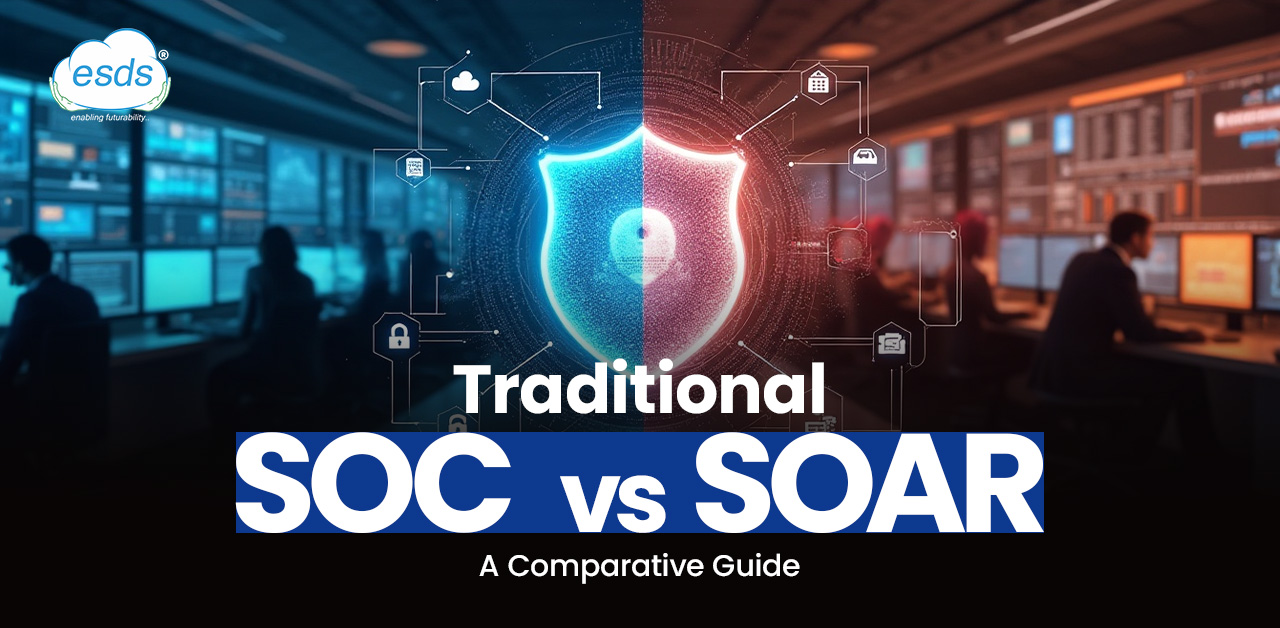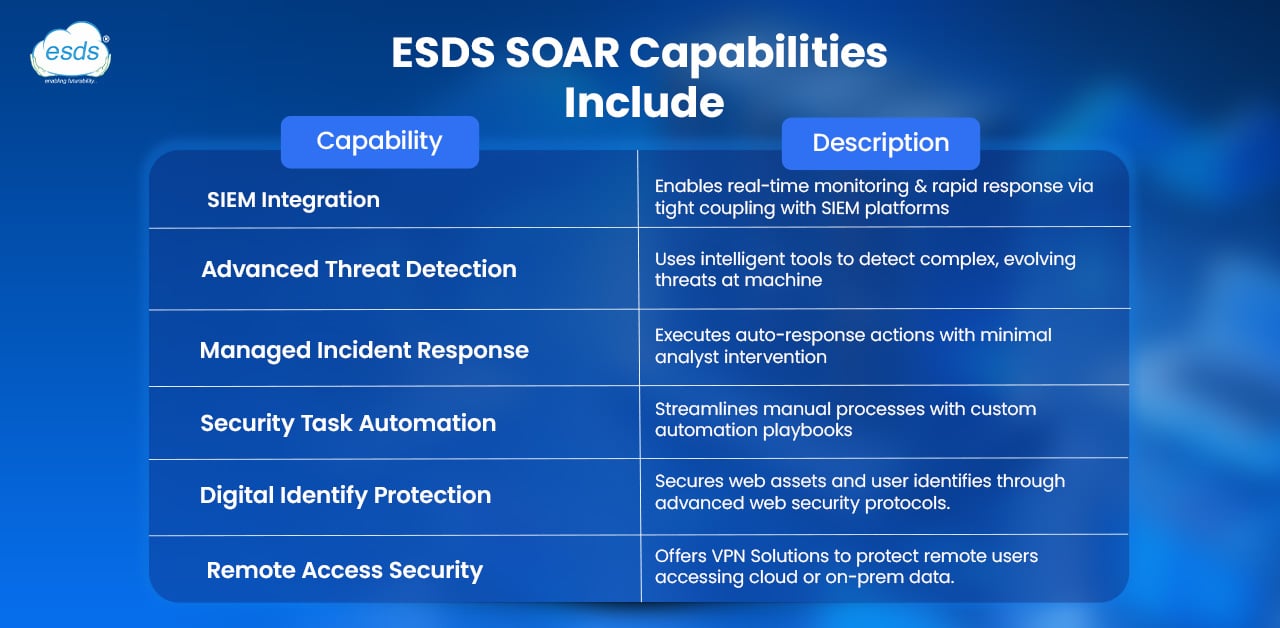SOAR vs Traditional SOC: A Comparative Guide

Cyber threats are evolving rapidly across the globe, posing increasing challenges to enterprise security teams. Organizations face increasing pressure to respond those attacks in swiftly and effectively. While Traditional Security Operations Centers (SOCs) have long been the first line of defense, they are being challenged by the emergence of SOAR (Security Orchestration, Automation, and Response) platforms.
As businesses and government bodies across India seek advanced, next-gen SOC models, the question becomes critical:
SOAR vs Traditional SOC – which is better suited for the evolving security landscape?
In this comparison guide, we break down the two models to help understand difference between them.
We are comparing traditional SOC and modern SOAR.
Let’s examine how they stack up across core parameters.
SOAR vs Traditional SOC: Comparison
To better understand the value of SOAR, it’s important to compare it with other prevalent security solutions, such as SOC. This will help organizations choose the most suitable solution for their security needs.
| Feature | Traditional SOC | SOAR |
| Alert Handling | Manual triage of thousands of alerts per day. | Automated correlation, enrichment, and triage. |
| Speed of Response | Hours to days (manual investigation) | Minutes or seconds (via automation) |
| Scalability | Limited to analyst capacity | Scales easily with digital infrastructure |
| Accuracy | High false positives, fatigue-prone | AI/ML based improves accuracy |
| Tool Integration | Poor interoperability | Unified dashboards with seamless integrations |
| Compliance Readiness | Manual logging/reporting | Auto-generated audit trails & reports |
| Human Dependency | High – requires 24/7 staff | Reduced – analysts focus on critical thinking |
| Security Automation | Low to none | Core functionality |
| Cost Efficiency | High OPEX due to staff | Lower TCO through automation |
| Time to Resolution | Variable | Consistent and fast |
Why Traditional SOC is No Longer Enough?
The SOC operations team received daily alerts, and more than that, some are false positives. Human analysts are drowning in noise, leading to alert fatigue, longer response times, and increased breach risks.
In India, where digital infrastructure like Aadhaar, Digi Locker, and Smart Cities rely on robust cyber defenses, these inefficiencies can have large-scale consequences.
Why SOAR Is the Foundation of a Next-Gen SOC
SOAR brings together three pillars: –
- Orchestration: Connects disparate tools (SIEM, EDR, threat intel, firewalls).
- Automation: Automates repeatable tasks like threat hunting, malware isolation, or phishing response.
- Response: Enables predefined playbooks to act instantly.
Advantages of Using SOAR
SOAR provides a range of benefits to organizations that includes: –
- Enhanced Efficiency: – Security teams may operate more productively and spend less time identifying, looking into, and fixing security events thanks to SOAR solutions, which automate repetitive operations and optimize security procedures.
- Improved Collaboration: – SOAR enhances cooperation and supports security teams in more efficiently responding to threats by giving them a centralized platform to coordinate, exchange information, and work together.
- Minimized Human Error: – In security operations, automation reduces the possibility of human error and guarantees that activities are carried out precisely and reliably. This improves an organization’s overall security posture and helps them avoid expensive errors.
- Scalability: – SOAR systems are scalable; businesses may expand and modify their security operations to meet changing business requirements. As businesses grow and change, this adaptability guarantees the ongoing security of digital assets.
Why You Should Choose ESDS SOAR Services?
ESDS is at the forefront of driving SOAR adoption across sectors. Their comprehensive Managed SOAR Services combine advanced threat detection, real-time collaboration, and intelligent automation to create a unified security.
Key Features of ESDS SOAR platform: –
- Predictive Threat Identification
ESDS SOAR uses threat intelligence to detect vulnerabilities and suspicious behaviour patterns before they escalate. This proactive capability ensures organizations stay ahead of evolving cyber threats.
- Automated Incident Response
ESDS SOAR automates key incident response workflows such as phishing mitigation, malware isolation, and suspicious login detection minimizing delays and reducing human error.
- Unified Tool Integration
The platform integrates seamlessly with your SIEM (Security Information and Event Management) systems, along with other tools like firewalls, IDS/IPS, and endpoint protection, creating centralized visibility across your security environment.
- Operational Efficiency
By automating common tasks such as collection, breach audits, and threat hunting, ESDS Tier 3 cloud infrastructure users to scale security operations without ballooning their staffing needs.
- Real-Time Collaboration
With features like Eagle Eye Services a subscription-based cybersecurity monitoring offering organizations get 24/7 visibility into threats with expert assistance from ESDS analysts.
ESDS SOAR Capabilities Include: –

SOAR India: Tailored for Scale, Speed, and Sovereignty
India’s digital mission demands secure-by-design systems. With public cloud often posing data sovereignty risks, SOAR-enabled community cloud models like ESDS Government Community Cloud offers: –
- Local data residency
- Auto-scaling secure infrastructure
- Threat detection for government and enterprises.
Final Thoughts: Choosing the Right Path Forward
While Traditional SOC created the structure, SOAR is increasingly being recognized as the better cyber defense, particularly in an era where speed, scalability, and automation are becoming essential.
If you’re evaluating cybersecurity frameworks that align with Indian compliance mandates, operational scalability, and long-term cost efficiency, adopting SOAR through a trusted provider ESDS.
Explore how ESDS’s SOAR can protect your infrastructure and ensure compliance with Indian regulatory standards.
Frequently Asked Questions (FAQs)
- What is SOAR in security?
Security Orchestration, Automation, and Response is referred to as SOAR. As the name implies, SOAR creates centralized control over security alerts and coordinates security measures. Additionally, it uses AI-powered actions and rule-based playbooks to automate incident response processes.
- Can SOAR work without SIEM?
It is possible for SOAR to function without SIEM. SIEM serves as a significant data source for SOAR, in order for it to operate, it must be able to absorb security data from security solutions such as Endpoint Detection and Response (EDR) systems.
- What is EDR vs SIEM vs SOAR?
Threat detection on endpoints is done by EDR, or Endpoint Detection and Response. By automating and coordinating security processes, SOAR is a security solution that shortens the time needed to identify and address threats.
